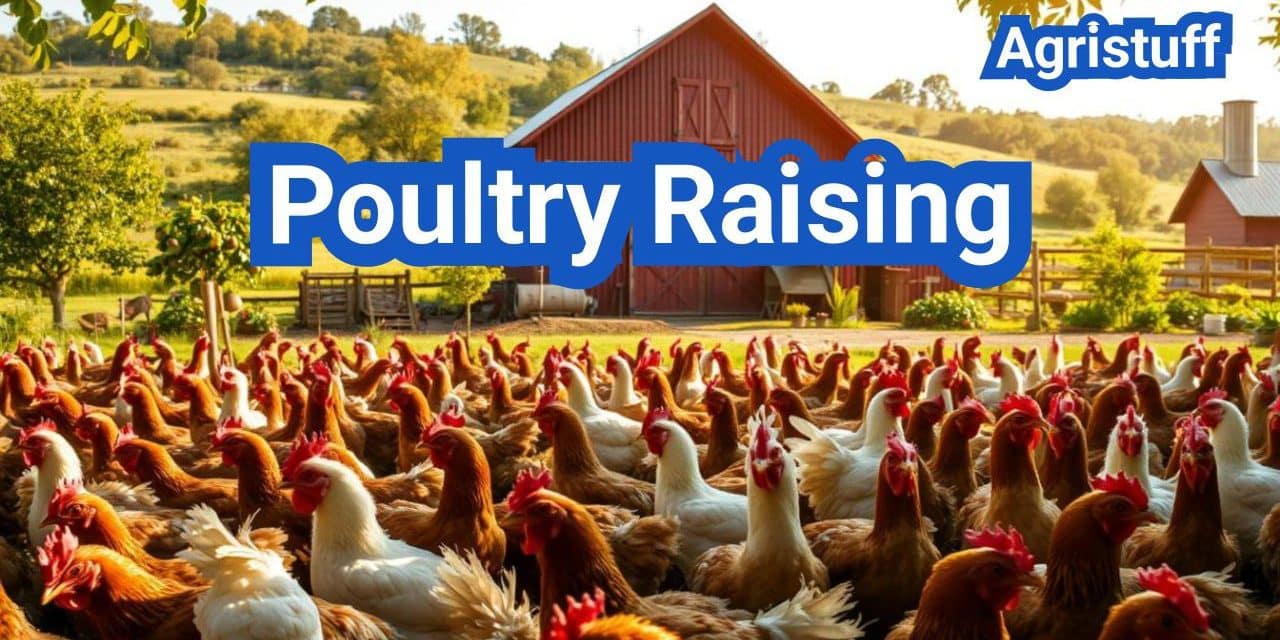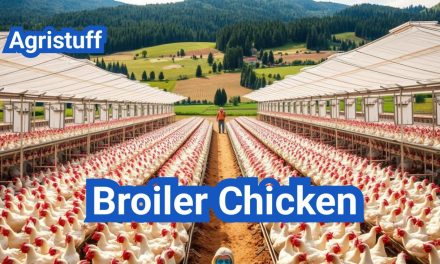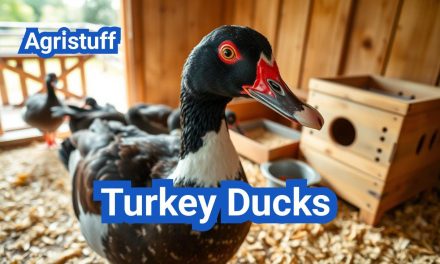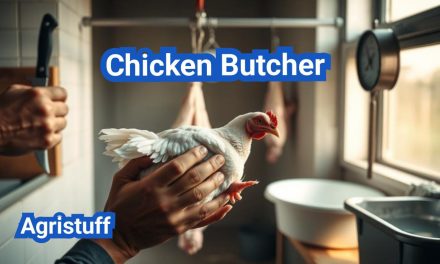Healthy chickens are the backbone of a profitable poultry business. Maintaining their health involves providing quality air, water, and feed. Efficient practices in poultry farming not only ensure the well-being of the chickens but also contribute to the overall profitability of the venture.
For those interested in raising chickens for eggs or keeping backyard chickens, understanding the basics of poultry care is crucial. This includes proper housing, feeding, and health care. By adopting efficient practices, individuals can enjoy a successful and profitable experience in poultry raising.
Key Takeaways
- Healthy chickens are crucial for a profitable poultry business.
- Quality air, water, and feed are essential for maintaining chicken health.
- Efficient practices contribute to the overall profitability.
- Proper housing, feeding, and health care are vital for poultry care.
- Adopting efficient practices leads to a successful poultry raising experience.
The Fundamentals of Profitable Poultry Raising
Starting a poultry-raising venture can be a lucrative and fulfilling endeavor for many farmers and backyard enthusiasts. To ensure success, it’s crucial to understand the foundational elements that contribute to a profitable operation.
Benefits of Raising Your Own Poultry
Raising your own poultry can provide numerous benefits, including a steady supply of fresh eggs and meat, as well as the satisfaction of raising your own food. Backyard chickens have become increasingly popular among urban and suburban dwellers looking to adopt a more sustainable lifestyle.
According to a study on sustainable agriculture, “backyard poultry production can contribute significantly to household food security and provide a means of income generation for families” (
“Sustainable Agriculture: The Basics,” n.d.,
USDA
). This highlights the potential forraising chickensto be both a hobby and a source of income.
Assessing Your Space and Resources | Poultry Raising
Before diving into poultry raising, it’s essential to assess your available space and resources. Consider the size of your yard and the number of chickens it can accommodate comfortably. The general rule of thumb is to provide at least 2-4 square feet per chicken inside the coop.
| Poultry Type | Space Requirement (sq ft/chicken) | Feed Consumption (lbs/chicken/month) |
|---|---|---|
| Layers | 2-4 | 15-20 |
| Broilers | 5-10 | 20-25 |
Legal Considerations and Local Ordinances | Poultry Raising
Understanding poultry farming regulations and local ordinances is critical to avoid potential legal issues. Many municipalities have specific laws governing the number of chickens allowed, coop requirements, and whether roosters are permitted.
- Check local zoning laws regarding backyard chickens.
- Comply with health and safety regulations.
- Consider neighbor relations and potential noise or odor issues.
By carefully assessing your space, understanding local regulations, and appreciating the benefits of raising poultry, you can lay the groundwork for a successful and profitable poultry-raising venture.
Essential Poultry Raising Equipment

Poultry raising equipment plays a vital role in maintaining a healthy and efficient farm. The right equipment not only ensures the well-being of your chickens but also streamlines your daily operations, making the entire process more manageable and profitable.
Basic Equipment for Beginners | Poultry Raising
For those just starting out in poultry raising, having the basic equipment is crucial. This includes a chicken coop, feeding equipment, and watering systems. A well-designed chicken coop provides a safe and comfortable environment for your chickens, protecting them from predators and harsh weather conditions.
Feeding equipment, such as feeders and grit containers, is essential for the nutritional health of your poultry. Automatic feeders can be particularly useful, as they help maintain a consistent feeding schedule and reduce waste.
Advanced Equipment for Commercial Operations | Poultry Raising
As your poultry raising operation expands, you may need to invest in more advanced equipment to increase efficiency and productivity. This can include automated egg collection systems, climate-controlled coops, and mechanized feeding systems.
| Equipment | Description | Benefits |
|---|---|---|
| Automated Egg Collection | System that gathers eggs from the coop | Reduces labor, minimizes egg breakage |
| Climate-Controlled Coops | Coops with temperature and humidity control | Improves chicken health, increases productivity |
| Mechanized Feeding Systems | Systems that automate the feeding process | Reduces labor, ensures consistent feeding |
DIY vs. Store-Bought Solutions | Poultry Raising
When it comes to poultry raising equipment, you have the option of either building your own DIY solutions or purchasing store-bought equipment. DIY solutions can be cost-effective and allow for customization to fit your specific needs. However, they may require more time and skill.
On the other hand, store-bought equipment is often designed with efficiency and durability in mind, potentially saving you time and effort in the long run. It’s essential to weigh the pros and cons of each option based on your operation’s size, budget, and specific requirements.
Selecting the Right Poultry Breeds
The key to a thriving poultry operation lies in selecting breeds that align with your specific needs and goals. Whether you’re raising poultry for eggs, meat, or both, the breed you choose significantly impacts your farm’s productivity and profitability.
Best Egg-Laying Chicken Breeds
For those focused on egg production, certain breeds stand out for their prolific laying abilities. Leghorns are renowned for their high egg production, laying up to 300 large white eggs per year. Other notable breeds include Rhode Island Reds and Barred Rocks, known for their consistent laying and hardiness.
“The average hen lays around 280-300 eggs per year, but this can vary significantly based on breed, nutrition, and management practices.”
— Poultry Farming Expert
When selecting egg-laying breeds, consider factors such as climate hardiness, temperament, and egg size to ensure they meet your farm’s specific needs.
Top Meat Chicken Breeds
For meat production, breeds that grow quickly and efficiently are preferred. Cornish Cross and Broiler breeds are among the most popular for their rapid growth rate and high-quality meat. These breeds are specifically designed for meat production, reaching market weight in as little as 6-7 weeks.
- Cornish Cross: Known for fast growth and high yield.
- Broiler: Optimized for meat production, with a focus on breast size and overall weight.
- Freedom Ranger: A slower-growing alternative, offering a more natural growth pattern and potentially better welfare outcomes.
Dual-Purpose Breeds for Small Farms
For small farms or backyard flocks, dual-purpose breeds offer a versatile solution, providing both eggs and meat. Plymouth Rock and Wyandotte are examples of dual-purpose breeds, known for their friendly disposition, decent egg production, and acceptable meat quality.
| Breed | Egg Production | Meat Quality | Temperament |
|---|---|---|---|
| Plymouth Rock | 280 eggs/year | Good | Friendly |
| Wyandotte | 200 eggs/year | Acceptable | Docile |
| Rhode Island Red | 300 eggs/year | Good | Active |
Selecting the right poultry breed is a critical decision that affects the overall success of your poultry operation. By understanding the characteristics of different breeds and aligning them with your production goals, you can optimize your farm’s efficiency and profitability.
Poultry Housing Solutions

Designing the right poultry housing is essential for the well-being of your flock. A well-structured coop not only protects your chickens from predators but also provides a healthy environment that promotes productivity.
Designing an Efficient Chicken Coop
An efficient chicken coop design considers several factors, including the size of the flock, the available space, and the local climate. The coop should be well-ventilated, dry, and draft-free. Adequate ventilation is crucial for removing moisture and ammonia from the coop, which can be harmful to the chickens.
Consider the climate when designing your coop. In colder climates, insulation is key to keeping the coop warm, while in hotter climates, shading and ventilation are essential for keeping the coop cool.
Space Requirements for Different Poultry Types
Different poultry types have different space requirements. For example, chickens require more space than ducks or turkeys. Generally, each chicken needs at least 3-4 square feet inside the coop. Outdoor runs should provide additional space, with a minimum of 10 square feet per chicken.
Ventilation, Lighting, and Temperature Control | Poultry Raising
Proper ventilation is vital for maintaining air quality inside the coop. Lighting also plays a significant role, especially in egg production. Natural light is ideal, but supplemental lighting may be necessary during winter months or in coops with limited natural light. Temperature control is equally important, as extreme temperatures can stress the flock.
- Ensure adequate ventilation to remove moisture and ammonia.
- Provide sufficient lighting for egg production and flock health.
- Maintain a comfortable temperature range for your flock.
Predator-Proofing Your Poultry Housing
Predator-proofing is a critical aspect of poultry housing. Secure fencing and hardware cloth can protect against predators like foxes, raccoons, and hawks. The coop itself should be sturdy and well-constructed, with no gaps or weaknesses that predators can exploit.
Regular inspections are necessary to ensure that the coop remains secure and that any damage is promptly repaired.
Raising Baby Chicks Successfully
The initial weeks of a chick’s life are critical, and proper brooding is essential. Creating a conducive environment for baby chicks is vital for their growth and development.
Brooding Equipment and Setup | Poultry Raising
Brooding equipment is fundamental in providing the necessary warmth and shelter for baby chicks. A brooder is essentially a enclosed space that can be a box, a plastic tub, or even a dedicated brooder. It should be well-ventilated, draft-free, and equipped with a heat source, such as a heat lamp or a heating pad, to maintain a temperature of around 90-100°F for the first few weeks.
Key components of brooding equipment include:
- A heat source (heat lamp or heating pad)
- A thermometer to monitor temperature
- A brooder or enclosed space
- Bedding material (pine shavings or straw)
Feeding and Watering Chicks
Feeding and watering are critical aspects of raising healthy baby chicks. Chicks need access to fresh water and starter feed that is rich in nutrients. The feed should be formulated specifically for chicks, and it’s essential to ensure that the feeders and waterers are clean and easily accessible.
Tips for feeding and watering:
- Use chick starter feed with 18-20% protein
- Provide fresh water daily
- Clean feeders and waterers regularly
Health Monitoring for Young Birds | Poultry Raising
Monitoring the health of baby chicks is crucial for early detection of any potential issues. Check for signs of illness, such as lethargy, labored breathing, or changes in droppings. Regular health checks can help prevent the spread of disease.
Health monitoring tips:
- Check for signs of illness daily
- Keep the brooder clean and dry
- Isolate any sick chicks immediately
Transitioning Chicks to the Main Coop | Poultry Raising
As chicks grow, they need to be transitioned to the main coop. This transition should be done gradually, ensuring that the chicks are fully feathered and the temperature outside is suitable. Introduce them to the coop during the day, allowing them to acclimate to the new environment.
Transition tips:
- Start by moving chicks to the coop during the day
- Gradually increase their time in the coop
- Ensure the coop is safe and secure
Comprehensive Poultry Management Practices

Comprehensive poultry management practices are essential for maintaining a healthy and productive flock. Effective management involves a combination of daily routines, seasonal considerations, and meticulous record keeping to ensure the overall profitability of the operation.
Daily Care Routines | Poultry Raising
Daily care routines form the backbone of poultry management. These routines include monitoring the health of the birds, ensuring access to clean water and nutritious feed, and maintaining a clean living environment. Regular inspections help in early detection of health issues, reducing the risk of disease outbreaks.
Feeding and watering systems should be checked daily to ensure they are functioning properly. Additionally, farmers should observe the behavior and condition of the birds daily to identify any signs of illness or stress.
Seasonal Management Considerations | Poultry Raising
Poultry management practices need to adapt to seasonal changes. For instance, during hot weather, it’s crucial to ensure adequate ventilation and provide cooling measures to prevent heat stress. In colder months, maintaining warmth and dryness in the coop is vital.
Seasonal adjustments might include modifying feeding schedules, adjusting coop insulation, or implementing parasite control measures. Understanding and preparing for these seasonal needs can significantly impact the health and productivity of the flock.
Record Keeping for Profitable Operations | Poultry Raising
Maintaining detailed records is a critical aspect of poultry management. Records should include data on feed consumption, growth rates, egg production, and health issues. Accurate record keeping enables farmers to make informed decisions, identify areas for improvement, and optimize their operations for profitability.
Records can also be invaluable in case of disease outbreaks or other issues, helping farmers to trace the source of problems and implement corrective actions.
Managing Multiple Age Groups | Poultry Raising
For many poultry farmers, managing multiple age groups is a reality. This requires careful planning and coordination to ensure that different age groups receive appropriate care. Segregating birds by age can help in tailoring feeding and health programs to their specific needs, improving overall flock health.
Managing multiple age groups also involves planning for the future, including decisions on flock replacement and expansion. Effective management of different age groups is key to maintaining a sustainable and profitable poultry operation.
Nutrition and Feeding Guidelines

Understanding the nutritional needs of your poultry is crucial for their health and productivity. A well-balanced diet supports growth, egg production, and overall well-being.
Understanding Poultry Nutritional Needs
Poultry require a diet rich in proteins, carbohydrates, fats, vitamins, and minerals. Proteins are particularly important for growth and egg production. The nutritional requirements can vary based on the age, breed, and purpose of the poultry (e.g., egg-laying, meat production).
A balanced diet for poultry typically includes a mix of grains, such as corn and wheat, and protein sources like soybean meal. Essential amino acids, vitamins, and minerals must be included to support various physiological functions.
Commercial vs. Homemade Feed Options | Poultry Raising
Poultry farmers can choose between commercial feed and homemade feed options. Commercial feeds are formulated to meet the nutritional needs of poultry and are convenient. However, they can be costly and may contain additives or preservatives.
Homemade feeds, on the other hand, allow for customization based on available ingredients and can be cost-effective. However, ensuring a balanced diet requires careful planning and knowledge of poultry nutritional needs.
- Commercial feed advantages: Convenient, formulated for nutritional balance.
- Commercial feed disadvantages: Can be expensive, may contain unwanted additives.
- Homemade feed advantages: Customizable, potentially cost-effective.
- Homemade feed disadvantages: Requires nutritional knowledge, can be time-consuming.
Feeding Schedules and Techniques | Poultry Raising
Establishing a consistent feeding schedule is vital for the health of your poultry. The frequency and amount of feed depend on the age, size, and breed of the birds.
For example, young chicks require more frequent feeding than mature birds. Feeding techniques also play a crucial role; for instance, using feeders that minimize waste and prevent contamination.
Supplemental Feeding for Optimal Health | Poultry Raising
Supplemental feeding can enhance the health and productivity of poultry. This can include providing additional nutrients or treats that are not part of their regular diet.
Examples of supplements include calcium for stronger eggshells and probiotics for gut health. However, it’s essential to introduce supplements judiciously to avoid nutritional imbalances.
By understanding and implementing appropriate nutrition and feeding guidelines, poultry farmers can significantly improve the health, productivity, and profitability of their operations.
Backyard and Urban Chicken Raising

Urban and backyard chicken raising offers a unique opportunity for city dwellers and homeowners to engage in sustainable living. This practice not only provides a source of fresh eggs but also serves as a hobby that can be both educational and fulfilling.
Space-Efficient Housing for Limited Areas | Poultry Raising
One of the primary concerns for urban residents is the lack of space. However, with careful planning, it’s possible to create efficient chicken housing that fits even the smallest of backyards. Vertical coops and multi-level chicken runs are innovative solutions that maximize space while keeping chickens safe and healthy.
When designing a chicken coop for a limited area, it’s essential to consider the number of chickens you plan to keep and their breed. Some breeds require more space than others, so selecting the right breed for your space is crucial.
Noise and Odor Management | Poultry Raising
Managing noise and odor is critical when keeping chickens in urban or suburban areas. Noise reduction can be achieved by using sound-absorbing materials in the coop and keeping the chickens calm through regular handling and a stress-free environment.
For odor management, regular cleaning of the coop is essential. Implementing a composting system for manure can also help reduce odors and provide a nutrient-rich fertilizer for your garden.
Neighbor Relations and Community Engagement | Poultry Raising
Keeping chickens in urban areas can sometimes be a point of contention with neighbors. Being a considerate chicken keeper involves maintaining a clean and quiet coop, respecting local regulations, and engaging with your community.
Community engagement can be fostered by sharing eggs with your neighbors, educating them about the benefits of backyard chickens, and participating in local chicken-keeping groups.
Pros and Cons of Keeping Urban Chickens
Keeping chickens in urban areas comes with its set of advantages and disadvantages. On the positive side, urban chickens can provide a steady supply of fresh eggs, serve as a teaching tool for children about responsibility and sustainability, and offer companionship.
However, challenges include navigating local ordinances, managing potential noise and odor, and dealing with predators. Weighing these pros and cons is essential for deciding if urban chicken keeping is right for you.
Raising Broilers for Meat Production

Efficient broiler production involves understanding growth cycles and feeding regimens. Raising broilers for meat requires a comprehensive approach that includes optimal growth cycles, appropriate feeding practices, humane processing, and thorough cost analysis.
Growth Cycles for Meat Birds | Poultry Raising
Broilers have specific growth cycles that need to be understood for optimal meat production. Typically, broilers are ready for processing between 6 to 8 weeks of age, depending on breed and production goals. Efficient growth cycle management involves monitoring weight gain, adjusting feed accordingly, and ensuring health checks are performed regularly.
Feeding Regimens for Optimal Growth | Poultry Raising
Feeding regimens play a crucial role in broiler production. Broilers require a diet rich in protein and nutrients to support rapid growth. Starter feeds are used from day one to around 3 weeks, followed by grower feeds until they are about 6 weeks old. Adjusting feeding regimens according to the growth stage is vital for optimal growth and health.
Humane Processing Considerations | Poultry Raising
Humane processing is a critical aspect of ethical broiler production. It involves handling birds with care, minimizing stress, and using processing methods that are as humane as possible. Proper training for handlers and adherence to animal welfare standards are essential components of humane processing practices.
Cost Analysis of Meat Production | Poultry Raising
Conducting a thorough cost analysis is necessary to understand the profitability of broiler production. This includes calculating the costs of feed, housing, healthcare, and processing, as well as the revenue generated from selling the meat. Efficient operations aim to minimize costs without compromising the health and welfare of the birds.
By focusing on these key areas, producers can optimize their broiler production systems for better efficiency, profitability, and animal welfare.
Maximizing Egg Production

To achieve optimal egg production, it’s crucial to understand the factors that influence laying hens. Egg production is a complex process affected by nutrition, light, and overall health.
Light Management for Year-Round Laying
Light management plays a critical role in maintaining year-round egg production. Hens require a certain amount of daylight to lay eggs consistently. Providing 14 hours of light per day can significantly enhance egg production during the shorter days of winter.
Nutrition for Peak Egg Production
Nutrition is another vital factor in maximizing egg production. Laying hens require a diet rich in calcium, protein, and other essential nutrients. A well-balanced diet not only supports egg production but also maintains the overall health of the hens.
| Nutrient | Function | Recommended Level |
|---|---|---|
| Calcium | Eggshell production | 3.5% |
| Protein | Overall health and egg production | 16-18% |
| Vitamin D3 | Calcium absorption | 1,000-2,000 IU/kg |
Collecting, Cleaning, and Storing Eggs
Proper egg handling is essential for maintaining egg quality. Eggs should be collected frequently, cleaned gently, and stored in a cool, dry place. Regular egg collection helps prevent breakage and keeps the eggs clean.
Troubleshooting Common Egg Production Issues
Despite best efforts, issues with egg production can arise. Common problems include stress, nutritional deficiencies, and health issues. Identifying the root cause of the problem is crucial for implementing effective solutions.
- Monitor hen health regularly
- Adjust nutrition according to laying stage
- Ensure adequate light and ventilation
Poultry Health Care Essentials

Poultry health care is a multifaceted approach that involves preventative measures, disease recognition, and biosecurity practices. Ensuring the health of your poultry is crucial for maintaining a productive and profitable farming operation.
Preventative Health Measures
Preventing disease is always more effective than treating it. Regular vaccinations and parasite control are essential components of a preventative health program. Additionally, providing a balanced diet rich in nutrients and ensuring access to clean water are fundamental to maintaining healthy birds.
- Implement a vaccination schedule tailored to your flock’s specific needs.
- Conduct regular checks for internal and external parasites.
- Ensure a nutritious diet that meets the nutritional requirements of your poultry.
Recognizing Common Poultry Diseases
Early detection of disease is critical for effective management. Familiarize yourself with the symptoms of common poultry diseases such as Avian Influenza, Newcastle Disease, and Coccidiosis. Recognizing these diseases early can help in taking prompt action to mitigate their impact.
- Monitor for signs of illness such as lethargy, loss of appetite, or unusual droppings.
- Isolate affected birds to prevent the spread of disease.
- Consult a veterinarian for accurate diagnosis and treatment advice.
Natural and Medicinal Treatment Options
While prevention is key, having a plan for treatment is also important. Natural remedies such as herbal supplements can be used alongside medicinal treatments prescribed by a veterinarian. It’s essential to understand when to use each approach effectively.
- Explore natural remedies that can support poultry health.
- Follow veterinary advice for medicinal treatments.
- Keep records of treatments and their outcomes to refine your approach.
Biosecurity Practices for Disease Prevention
Biosecurity measures are vital for preventing the introduction and spread of diseases. Implementing strict biosecurity protocols can significantly reduce the risk of disease outbreaks. This includes controlling access to your poultry area, using disinfectants, and ensuring that visitors follow proper hygiene practices.
- Limit access to your poultry to essential personnel only.
- Use foot baths and hand sanitizers for visitors.
- Regularly clean and disinfect equipment and housing.
Economics of Small-Scale Poultry Farming

Understanding the financial aspects of small-scale poultry farming is crucial for success. This involves not just the initial investment but also ongoing operational costs and strategies for maximizing return on investment.
Startup and Operational Costs
The initial startup costs for small-scale poultry farming include purchasing land, building or renovating poultry housing, buying initial stock, and acquiring necessary equipment. Operational costs encompass feed, veterinary care, labor, and marketing expenses. It’s essential to create a detailed budget that accounts for these costs to avoid financial strain.
Calculating Return on Investment
To calculate the return on investment (ROI) for a small-scale poultry farm, farmers need to consider both the income generated from sales and the total costs incurred. ROI calculation helps in understanding the profitability of the operation. It’s calculated by dividing the net profit by the total investment and then multiplying by 100 to get a percentage.
Scaling Your Poultry Operation
Scaling a poultry operation involves strategic planning to increase production while maintaining or reducing costs per unit. This can be achieved through economies of scale, such as bulk purchasing of feed and supplies, or by improving efficiency through better management practices or technology.
Tax Considerations for Poultry Farmers
Poultry farmers should be aware of the tax implications of their business. This includes understanding deductions available for agricultural businesses, such as expenses for feed, veterinary care, and equipment. Consulting a tax professional can help in navigating these deductions and ensuring compliance with tax laws.
Building a Sustainable and Profitable Poultry Business
Building a sustainable and profitable poultry business requires careful planning, efficient management, and a deep understanding of poultry farming practices. By integrating the tips and strategies outlined in this article, farmers can create a thriving operation that benefits both the environment and their bottom line.
Key to success lies in selecting the right poultry breeds, designing efficient housing, and implementing comprehensive management practices.
Farmers must also prioritize poultry health care, nutrition, and feeding guidelines to ensure optimal production. By doing so, they can establish a profitable poultry raising operation that is both sustainable and environmentally friendly.
By following these poultry farming tips, farmers in the United States can build a successful and sustainable poultry business, contributing to a more environmentally conscious and food-secure future.
FAQ
What are the benefits of raising my own poultry?
Raising your own poultry provides a sustainable source of eggs and meat, allows for humane treatment of animals, and can be a cost-effective way to produce food. Additionally, it can be a rewarding hobby and a way to connect with your community.
How do I assess my space for poultry raising?
To assess your space, consider the size of your yard, the amount of sunlight and shade, and the proximity to neighbors. You’ll also need to evaluate the availability of resources such as water and feed.
What are the essential equipment needed for poultry raising?
Essential equipment includes a chicken coop, feeding and watering systems, and fencing to protect your birds from predators. You may also need brooding equipment for raising baby chicks.
How do I choose the right poultry breed for my needs?
Consider factors such as egg production, meat production, climate hardiness, and temperament when selecting a breed. Research different breeds to determine which ones best suit your goals and environment.
What are the key considerations for designing a chicken coop?
A well-designed coop should provide adequate ventilation, protection from predators, and sufficient space for your birds to move comfortably. It should also be easy to clean and maintain.
How do I ensure the health and well-being of my poultry?
Provide a balanced diet, ensure access to clean water, and maintain a clean and safe living environment. Regularly inspect your birds for signs of illness or stress, and take preventative measures against disease.
What are the best practices for feeding my poultry?
Provide a nutritionally balanced diet that meets the needs of your birds. Consider factors such as age, breed, and production level when determining feeding schedules and techniques.
How can I maximize egg production?
Ensure your hens receive adequate nutrition, maintain a comfortable and stress-free environment, and provide sufficient light. Collect eggs regularly to encourage continued production.
What are the considerations for raising broilers for meat production?
Consider factors such as growth rate, feed efficiency, and humane processing practices when raising broilers. Ensure that your birds are raised in a healthy and safe environment.
How do I manage the economics of small-scale poultry farming?
Carefully track startup and operational costs, calculate return on investment, and consider strategies for scaling your operation. Stay informed about market trends and consumer demand.
What are the key factors to consider when raising chickens in a backyard or urban environment?
Consider factors such as space constraints, noise and odor management, and neighbor relations when raising chickens in a backyard or urban environment.
How can I ensure biosecurity on my poultry farm?
Implement practices such as restricted access, sanitation, and disinfection to prevent the introduction and spread of disease. Stay informed about disease risks and take proactive measures to mitigate them.
Conclusion Of: Poultry Raising
Poultry raising is a valuable and increasingly popular agricultural practice that provides substantial opportunities for profit, particularly in the USA. Whether you’re interested in egg production, meat, or both, understanding key poultry raising tips can significantly enhance your success and profitability. Learn more about poultry industry trends from the USDA.
Benefits of Poultry Raising
Engaging in poultry raising offers numerous advantages such as minimal startup investment compared to other livestock ventures, fast returns, and a stable market demand. Poultry raising is accessible even to beginners, providing an ideal entry point into agriculture. Explore beginner-friendly poultry farming guides from Penn State Extension.
Selecting Suitable Poultry Breeds
Successful poultry raising begins with choosing the right breeds. For egg production, breeds like Rhode Island Reds and Leghorns are optimal, while Cornish Cross and Jersey Giants are well-suited for meat production. Selecting the correct breed aligns with your poultry raising objectives. Compare breed performance data from the University of Kentucky.
Proper Housing and Shelter
Adequate housing is essential in poultry raising to protect birds from weather extremes and predators. Housing should include sufficient ventilation, space, insulation, and security to maintain bird comfort and health. Review housing guidelines from the Mississippi State University Extension.
Nutrition and Feeding Strategies
Effective poultry raising requires meticulous attention to poultry diets. Providing balanced nutrition that includes grains, protein, vitamins, and minerals is vital. Proper feeding strategies significantly influence productivity, growth rates, and overall poultry health. Refer to feed formulation research from the University of Georgia.
Water Supply Management
Ensuring a clean and consistent water supply is crucial for poultry raising. Reliable watering systems reduce contamination risks, maintain hygiene, and support bird health and productivity. Read water management best practices from the FDA.
Health Care and Disease Prevention
Health management is fundamental to profitable poultry raising. Regular veterinary check-ups, vaccinations, parasite control, and biosecurity measures effectively prevent diseases and promote overall flock health. Access biosecurity protocols from the CDC.
Efficient Egg Production
For those focusing on poultry raising for egg production, understanding laying cycles, providing comfortable nesting boxes, and timely egg collection are essential. Efficient egg management practices enhance productivity and profitability. Learn about egg production systems from Iowa State University.
Effective Meat Production
If your poultry raising operation targets meat production, prioritize proper feed management, growth monitoring, and humane slaughter practices to maintain high-quality poultry meat and meet market standards. Explore meat processing guidelines from the USDA FSIS.
Climate and Environmental Management
Maintaining an ideal environment is critical in poultry raising. Proper temperature control, ventilation, and moisture management significantly enhance poultry comfort, reduce stress, and increase productivity. Study environmental control systems from Purdue University.
Flock Management Practices
Good flock management practices, including careful monitoring of bird behavior, productivity assessments, and implementing corrective actions promptly, are essential for successful poultry raising operations. Review flock health resources from the University of California.
Marketing and Sales Strategies
Developing robust marketing strategies is integral to profitable poultry raising. Utilizing farmers’ markets, direct-to-consumer sales, online platforms, and local stores can effectively boost your business visibility and profits. Discover marketing tips from the Small Business Administration.
Financial Planning and Budgeting
Profitable poultry raising requires effective financial management. Accurate budgeting, tracking expenditures, and monitoring revenue are crucial for sustainable profitability and growth. Access farm financial tools from the USDA Farm Service Agency.
Record Keeping
Maintaining thorough records of your poultry raising operations, including bird health, production data, feed consumption, and financial transactions, is essential. Good record keeping facilitates informed decisions and enhances farm profitability. Download record-keeping templates from the University of Maryland.
Avoiding Common Mistakes
Many beginners in poultry raising encounter challenges like overcrowding, improper nutrition, and inadequate disease prevention measures. Educating yourself and meticulous planning help prevent these common pitfalls. Learn from common mistakes via the University of Florida IFAS.
Regulatory Compliance
Compliance with local and federal regulations is essential for sustainable poultry raising. Understanding applicable laws, obtaining necessary permits, and adhering to animal welfare standards ensures smooth operations. Check USDA poultry regulations here.
Sustainable Practices
Incorporating sustainability into your poultry raising operations, through responsible waste management, recycling, and environmental conservation, ensures long-term viability and benefits the broader community. Explore sustainable poultry farming from the EPA.
Expansion and Diversification
As your poultry raising business matures, consider opportunities to diversify products, introduce new poultry breeds, or expand farm size, further enhancing your profitability and sustainability. Read about farm diversification strategies from the USDA NIFA.
Final Thought
Successful poultry raising relies on informed planning, efficient management practices, and continuous learning. By implementing these tips, you can ensure a profitable and rewarding poultry raising venture. For further reading, visit the National Agricultural Library.










